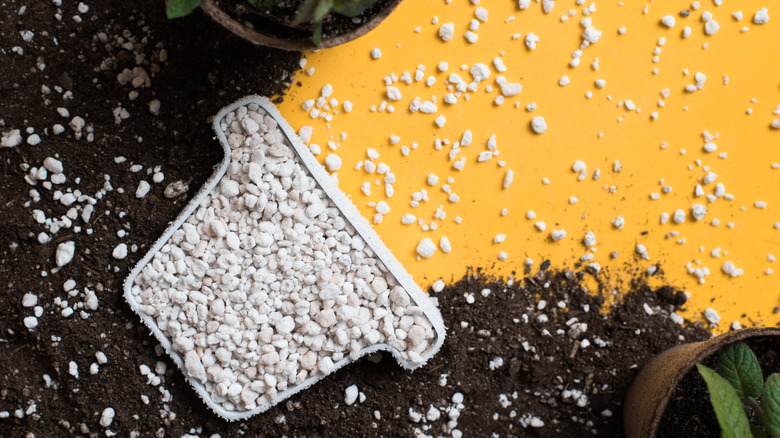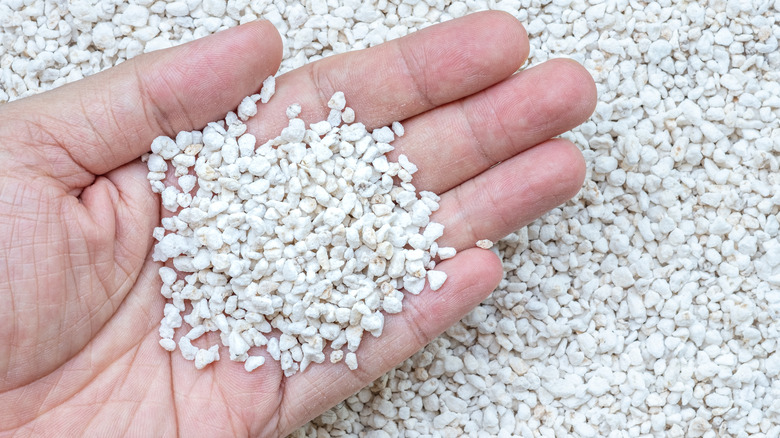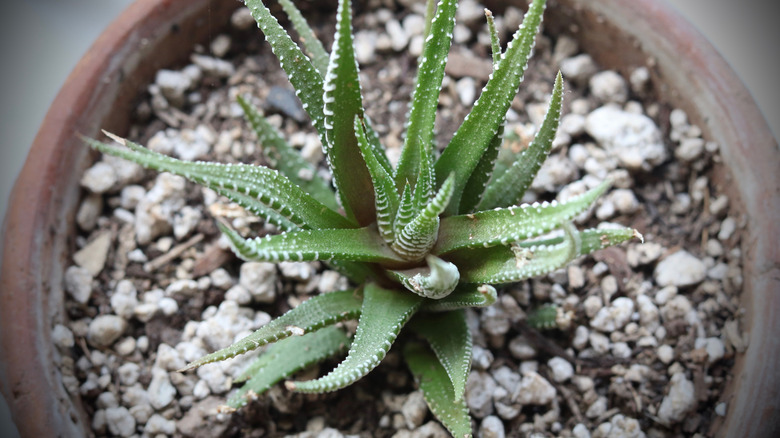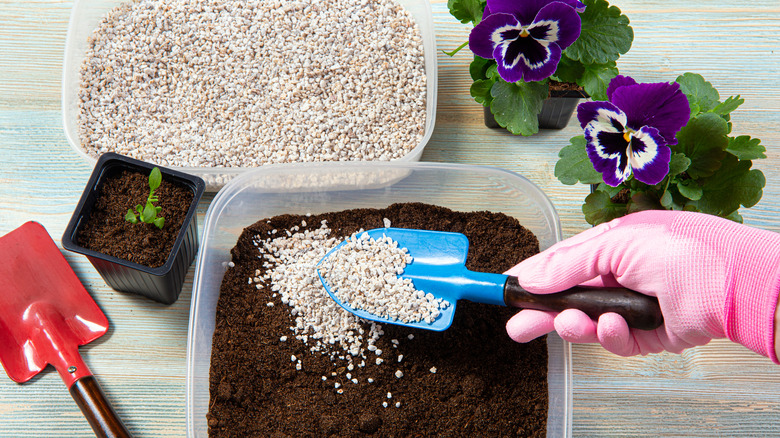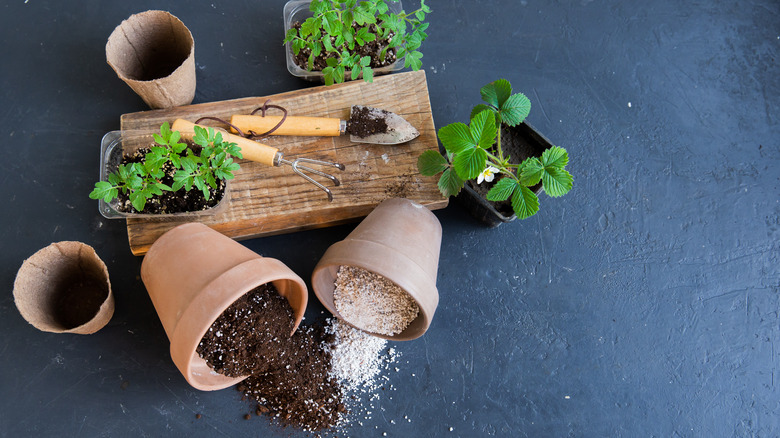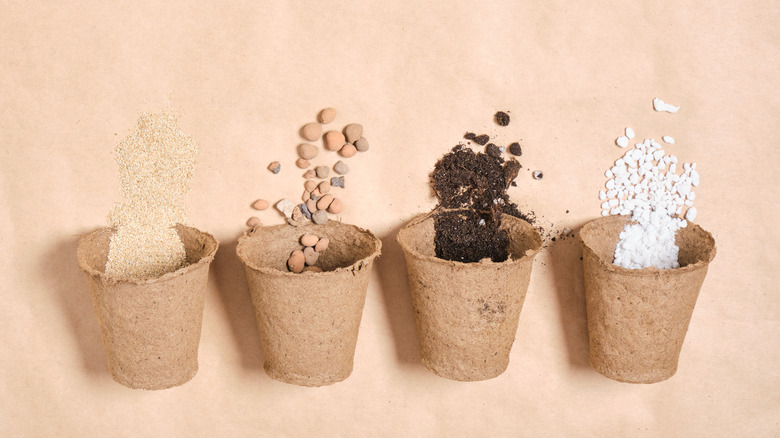What Is Perlite And How Does It Help Your Garden?
Perlite is a soil additive frequently mixed with peat moss and dirt to create a well-draining potting mix. It looks like small styrofoam balls but is actually made from volcanic glass. According to Trees.com, perlite is created by "popcorning" volcanic glass. This process heats the glass to about 1650°F, causing the glass to pop like popcorn and expand in size. During the popping, the perlite becomes porous. Being porous is what makes it so useful in horticulture.
Perlite has been around since at least the third century B.C. It's a versatile organic material used in industrial buildings, swimming pool filters, and even our drinking water filters. However, in horticulture, perlite is used to aerate soil, add drainage to dirt, take the place of soil in hydroponic planting, propagate cuttings, and ground cover. While perlite is safe for plants, you should take precautions when handling it because the dust can be harmful to your eyes and lungs.
What is perlite?
Perlite is a volcanic rock. It is dense and heavy in its natural form, the opposite of its state after the popcorn process. It's a naturally occurring mineral and is not a renewable resource. According to Trees.com, perlite contains ingredients like silicon dioxide, iron oxide, calcium oxide, and water. The volcanic rock made into perlite is created when lava comes out of a volcano and quickly cools, trapping moisture and giving the rock its glass-like appearance (via Sciencing). The major perlite producers are the U.S., Greece, Turkey, and Japan.
Perlite aerates and drains water from soil so well because it's porous. When the volcanic rock is heated until it pops like popcorn, tiny holes are created throughout the rock. The porous texture, coming from the tiny holes, allows air to get trapped in the perlite and the soil that the perlite is mixed into. You want your plants to have soil with aeration, so water distributes evenly, and your plant's roots can absorb oxygen and nutrients (via Treehugger).
Types of perlite
Perlite comes in four sizes or grades. These are super coarse grade #4, coarse grade #3, medium grade #2, and fine grade #1. The coarsest grade measures 1 inch in diameter, and the finest grade measures 1/8 inch. It's good to know about the size options and when they are used so you can get the best use of your perlite. When using perlite in horticulture, the medium grade is used the most. According to Garden Betty, this is used in potting mixes and the commercial perlite bags available for home gardeners.
Super coarse and coarse grade perlite is used with only super dense soil to stop water retention in garden beds and raised beds. Garden Betty recommends only using fine-grade perlite for starting seeds or propagating cuttings. If fine perlite is used in any other potting mix, especially outside, the wind will likely blow it away. That or it wouldn't be big enough to make a difference in your soil.
How to use perlite
Perlite has many uses in horticulture. It is most known as a soil additive to create a potting mix with more drainage. That's why when you open a bag of premixed cactus or succulent soil, you see more specs of white styrofoam (aka perlite) than if you opened a bag of all-purpose potting mix. However, many gardeners mix their own potting soil. This allows them to adjust the amounts of perlite, peat moss, and loam for each plant's specific needs. If you're repotting plants like aloe vera, jade, pothos, or ZZ plants, you should add more perlite to your potting mix. Gardeners' World suggests using a 1:4 ratio of perlite to compost or loam.
Adding perlite to hydroponic planters (plants growing in water) is also helpful because the perlite acts like a sponge, wicking away excess moisture from the roots. If you mix it with vermiculite, it helps the vermiculite hold water. You would use a 50:50 ratio of vermiculite and perlite if you are sowing seeds or propagating cuttings that need to stay moist. Perlite is also frequently used as coverage on the surface of the soil. Adding perlite on top of the soil creates a barrier between water and the soil, allowing only some water to drain through. This would be a good idea when landscaping using plants that don't want a lot of water.
Pros and cons of perlite
While perlite is very useful and great at what it does, it has some downsides. According to Leafy Place, one con is that perlite doesn't come from a renewable resource, and so it won't last forever. Perlite also floats if you add too much water to your pot because of the air trapped inside. However, you can avoid this problem by not adding excess water to your plants, which you should already be avoiding so that you don't give them root rot. The finer grades of perlite have a similar problem. Because they are so small, they are often blown away in the wind. The dust that comes off of perlite is also dangerous to our health. Perlite irritates eyes and respiratory systems, so always wear a dust mask and goggles or add water to your perlite before handling it.
Although perlite has some cons, they are easily avoidable. A big pro about perlite is how cheap it is. It is available at most hardware stores for an average of $5 for an 8-quart bag (via Home Depot). And, of course, perlite is great at adding aeration, improving drainage, and for using in hydroponic gardening.
Is perlite safe?
Perlite is very useful in gardens, but is it safe? Looking at your plants' health, there is little harm that perlite could do. It has a neutral pH level, so it will not change your soil, and it's made of naturally occurring materials, so it doesn't contain any dangerous toxins, according to Gardens Alive. If you're looking to grow organic produce, perlite is a good additive for your soil. The only potential problem is fluoride burn. This happens when there is too much fluoride in the dirt, and the tips of the leaves turn brown. However, fluoride burns are more likely caused by fluoridated water, superphosphate fertilizers, or low soil pH and not perlite.
When handling perlite, you should use caution because of its dust. The dust is labeled a "nuisance dust," and the most harm it will do is aggravate respiratory conditions and irritate eyes, according to The Spruce. Depending on who you bought your perlite from, you should take extra precautions because it becomes harmful when perlite is mixed with quartz. This is because quartz is listed as a carcinogenic substance. You can protect yourself by adding water to your bag of perlite, which decreases the amount of dust, or by wearing a dust mask and goggles.
